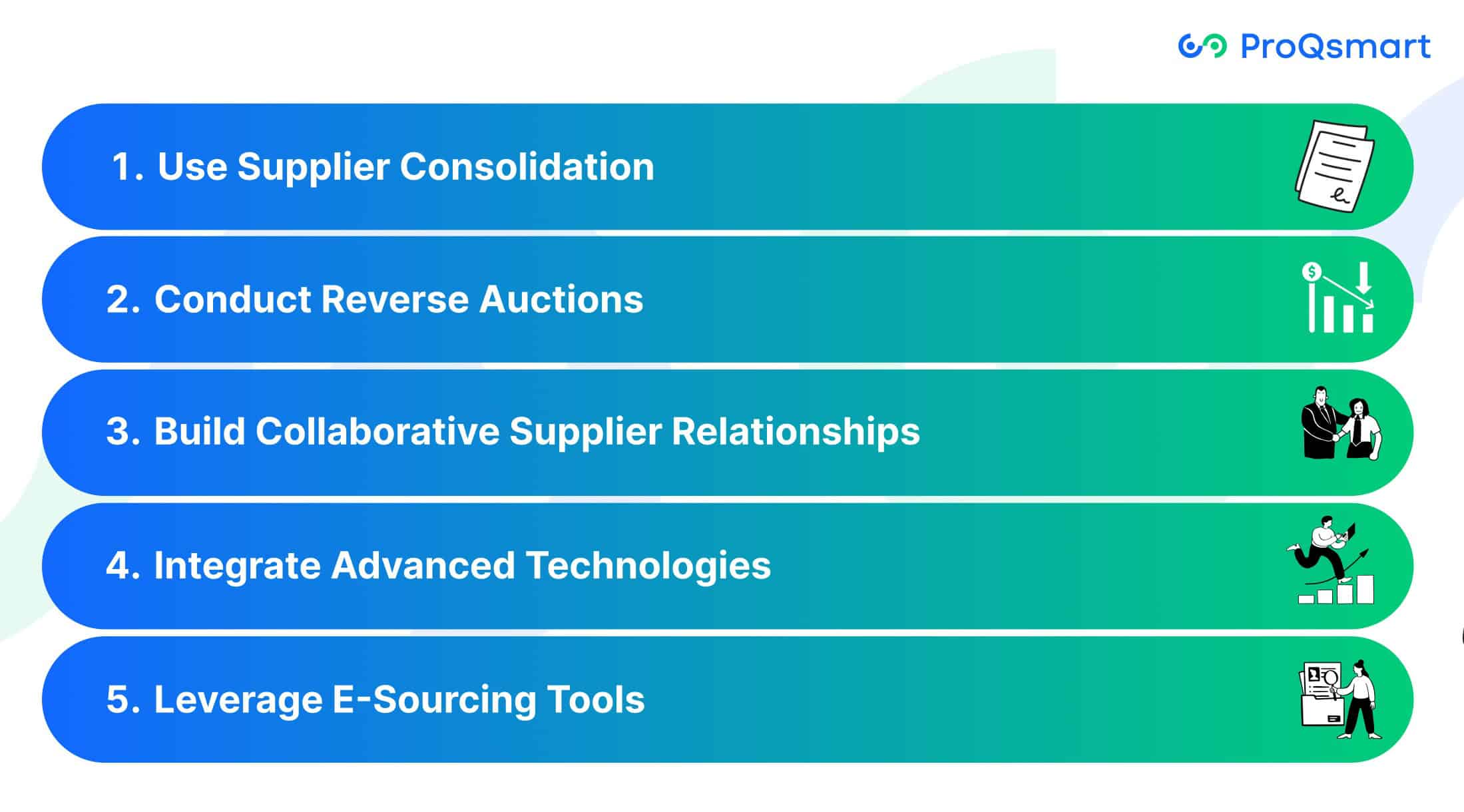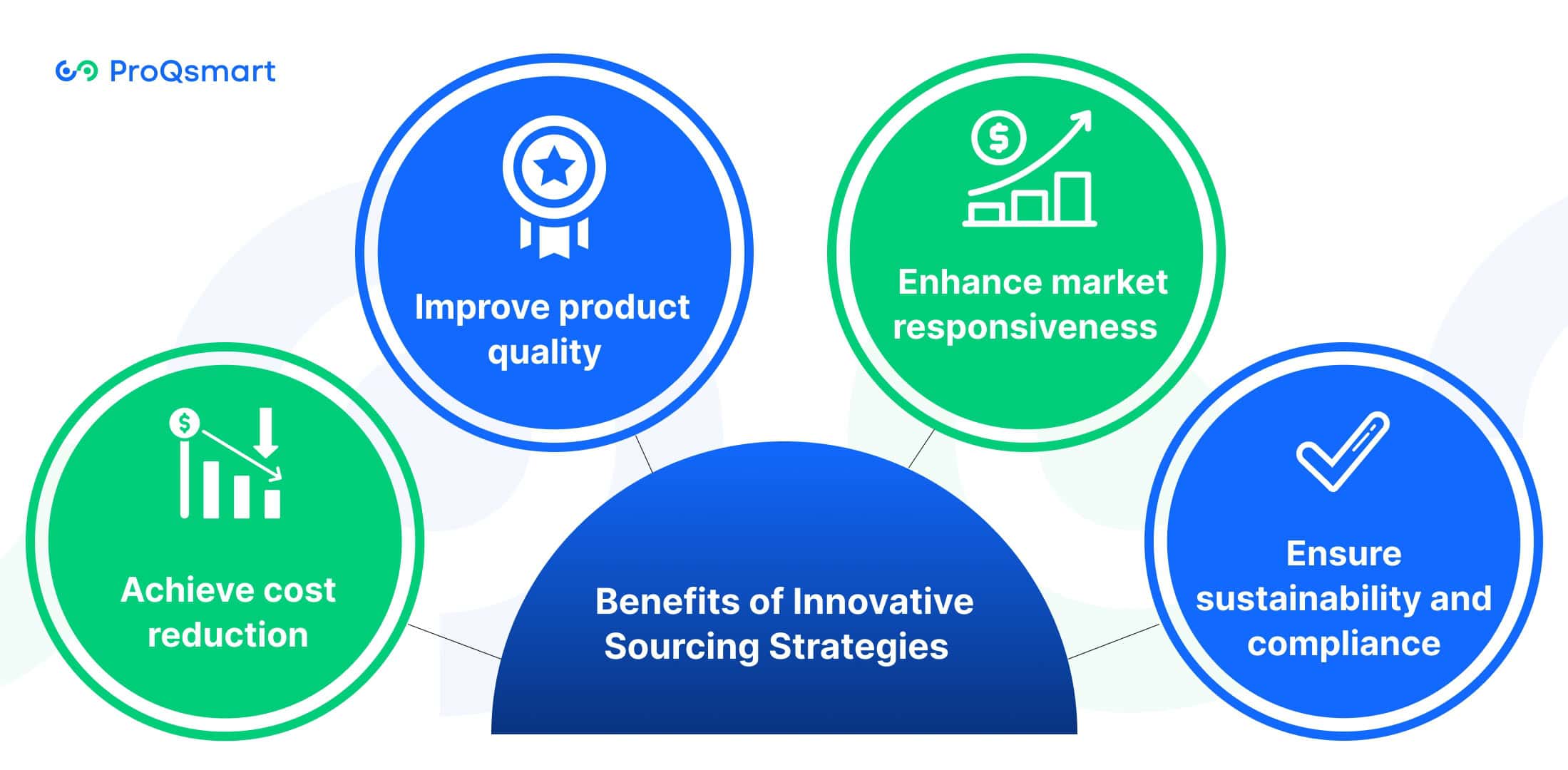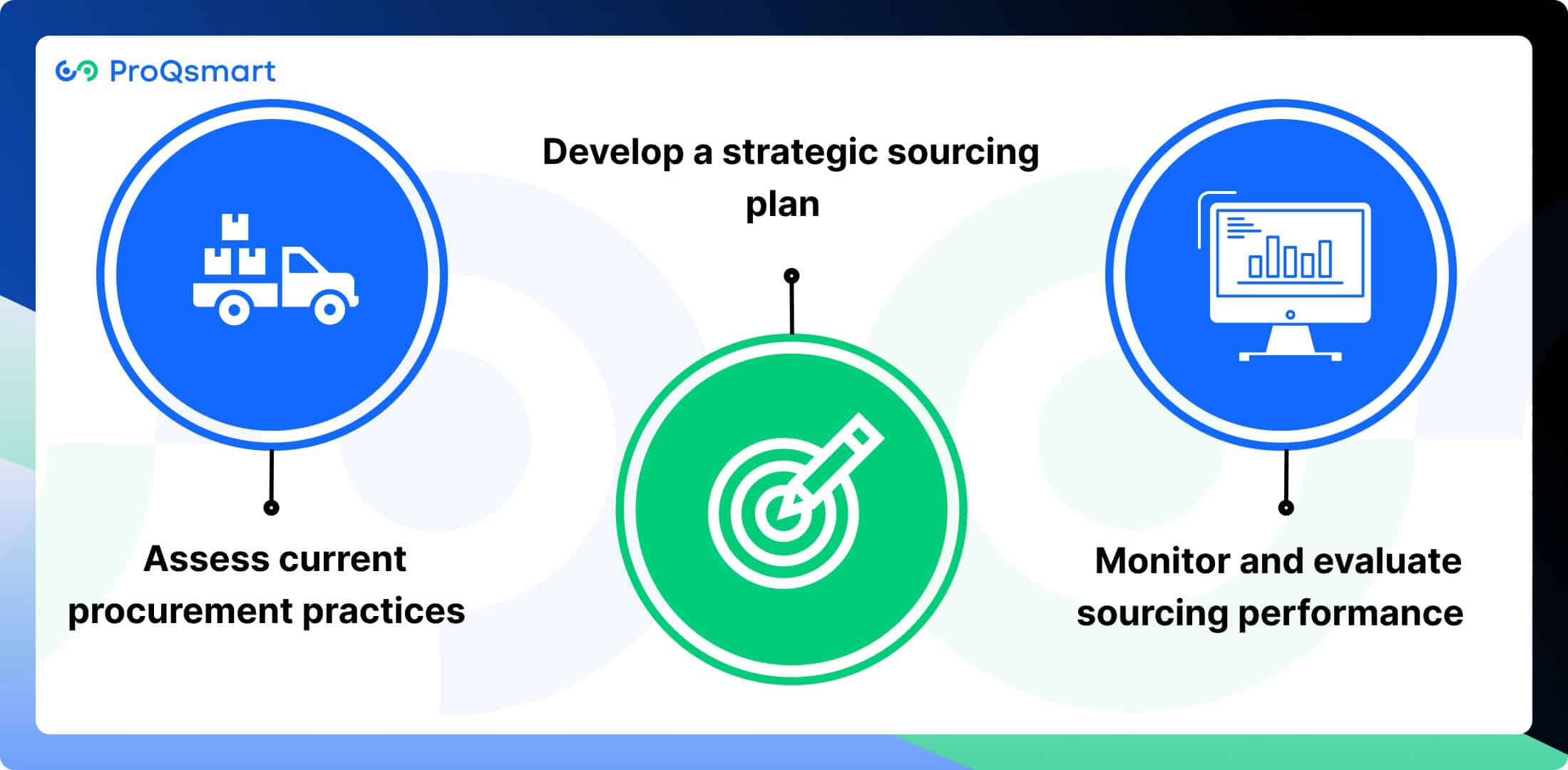Sourcing in procurement is essential for any business. It allows them to procure the right products better and services at the most advantageous value. It’s the process of finding, comparing, and choosing the best suppliers that meet the needs and objectives of the organization.
Well-planned sourcing strategies lead to increased savings, better supplier relationships, and faster operations. Procurement professionals use market trends, data analysis, and supplier performance to power informed decisions. This combined approach is what’s powering our efficiency and sustainability efforts.
By leveraging technology, like procurement software, the process is made even more efficient, creating streamlined workflows and more transparency. It establishes the foundation for a robust, more nimble supply chain, enabling durable success in an increasingly competitive marketplace.
Understanding Sourcing in Procurement
Sourcing plays a proactive role in making sure that the company’s suppliers reflect the company’s objectives and values. For instance, if a company values sustainability, sourcing strategies would be directed toward suppliers that implement sustainable practices.
The sourcing process typically involves several steps:
Identifying potential suppliers
Evaluating their capabilities
Negotiating terms
Finalizing contracts.
Each step is important in establishing how much the goods will cost, their quality, and how well the goods are delivered in a timely manner.
For example, when qualifying suppliers you may need to consider their financial stability, production capacity and track record. Strategic sourcing also allows you to connect with other procurement functions naturally.
It affects everything from budgeting and inventory management to adherence to organizational standards or guidelines. Because of this, decisions made during the sourcing process directly impact the total cost and quality of the goods procured. This impact is why sourcing is a pillar of procurement efficiency.
Differentiating sourcing from procurement
Sourcing is just one part of procurement. Procurement encompasses all aspects of purchasing goods and services. This spans production planning, procurement, and warehouse stocking.
By comparison, sourcing focuses on developing rapport with suppliers and making optimal supplier selections. For instance, while sourcing can focus on the use of competitive bidding to negotiate contracts, procurement responsibilities extend to placing the order and paying the bill.
The objectives of sourcing and procurement differ. Sourcing prioritizes building collaborative vendor relationships and securing favorable terms. Procurement aims to ensure the availability of materials to meet production needs.
Activities like supplier risk assessment or market analysis are specific to sourcing, whereas inventory control falls under procurement.
An Overview of Strategic Sourcing
Strategic sourcing is a more strategic and future-oriented approach to procurement. It centers around maximizing the entire procurement process with a smart, systematic approach comprising a set of defined steps. These steps typically involve understanding organizational requirements, performing a market analysis, creating sourcing strategies, choosing suppliers, and executing contracts. This comprehensive procurement process involves effective sourcing strategies that align with long-term business objectives.
Unlike historical approaches, which typically focus on short-term requirements and driving costs down, strategic sourcing emphasizes proactive planning and delivering value over time. At its core, this sourcing solution is about being proactive when it comes to supplier relationships, which includes consolidating purchases into categories for better efficiency.
For instance, categorizing products as raw materials and office supplies enhances the procurement process. Processes such as supplier evaluation, performance monitoring, and continuous improvement are embedded into a robust framework. A consumer goods company can work collaboratively with their suppliers to achieve cost and sustainability targets, ensuring that their sourcing model aligns with their corporate values.
That kind of collaboration helps keep a company’s corporate values in sync. At the heart of it all is continuous improvement. Strategic sourcing is not a one-shot deal, but an iterative process. By adopting this mindset, organizations can better position themselves to reduce costs, increase supplier performance, and stay compliant with regulations.
Tools such as ProQsmart’s Source-to-Pay software automate complementary activities such as contract management, helping procurement teams work smarter and faster, ultimately leading to a successful sourcing strategy.
Importance of strategic sourcing in procurement
This is where strategic sourcing comes in — it’s a key driver in cutting procurement costs. By adopting effective sourcing principles instead of just focusing on purchase price, companies can uncover savings that were previously hidden. For example, analyzing tier-one and tier-two supplier data can reveal inefficiencies, allowing organizations to direct resources where they’re most needed.
Collaboration is another benefit of a successful sourcing strategy. Strong supplier relationships drive innovation, providing exposure to new technology or even access to proprietary products. Strategic sourcing supercharges risk management; with 95% of businesses experiencing pandemic-related disruptions, a reliable supplier network helps organizations maintain stability during crises.
Sustainability is an increasing priority in procurement management. Ethical sourcing and eco-friendly practices align with today’s consumer expectations, enhancing brand reputation. Companies that excel in these strategic initiatives will gain a competitive edge, establishing themselves as leaders in their markets.
Key differences from traditional sourcing
While traditional sourcing responds to last-minute needs, the strategic sourcing process is proactive and focuses on building supplier partnerships rather than one-time transactions. This approach leads to more collaborative relationships and enhances supplier relationship management. Advanced tools such as artificial intelligence and machine learning further analyze spending patterns and supplier performance, resulting in healthier, more strategic decisions that align with sourcing needs.
Strategic sourcing takes a longer-term view to value by considering the overall cost of ownership, including maintenance and operational costs, rather than just the initial purchase price. For example, opting for an energy-efficient piece of equipment may have a higher upfront cost but can save you $100,000 over its lifetime, demonstrating an effective sourcing strategy.
Innovative Sourcing Strategies

This is why sourcing is the secret weapon of procurement and why innovative sourcing strategies can take it to the next level. By embracing creative and flexible approaches, organizations can enhance efficiency, adapt to dynamic market conditions, and align sourcing practices with broader business goals.
When approached thoughtfully, innovative sourcing becomes more than an opportunity to work smarter—it’s a source of competitive advantage that fuels growth while supporting people and the planet.
1. Use Supplier Consolidation
Consolidating suppliers is another pragmatic approach to ease the burden of procurement. Organizations can reduce large costs by decreasing vendor count. This strategy gives them leverage to negotiate better contracts and market-based bulk purchase discounts.
For instance, a manufacturing company that consolidates its metal suppliers can negotiate a single bulk contract, cutting costs by up to 15%. Having fewer suppliers also simplifies the task of performance monitoring, so that teams can ensure and emphasize quality and reliability.
By having a centralized, comprehensive management process, the risks of supply chain disruption are mitigated, and procurement processes are made more efficient.
2. Conduct Reverse Auctions
In a reverse auction, suppliers compete for your business with lower bids, driving down costs. This open-source process fosters robust competition, helping to prevent favoritism and cronyism, while saving time compared to more conventional negotiations.
In one case, a construction company employed reverse auctions as a sourcing strategy, saving 12% on procurement costs. Success relies on having strong specifications and requirements.
Solutions such as ProQsmart’s Source-to-Pay solution further amplifies this by automatically integrating market intelligence, ensuring accuracy, and identifying cost-saving opportunities.
3. Build Collaborative Supplier Relationships
Deep supplier relationships are built on a foundation of transparency and common purpose. Innovation thrives with open communication, leading to improved product quality and service levels through innovative sourcing strategies.
These relationships foster an environment where collaboration can flourish, resulting in benefits such as shortened lead times and higher standards for materials. By working closely with suppliers who share similar values and goals, organizations can create win-win situations that enhance overall performance. This collaborative approach not only drives efficiency but also encourages the sharing of best practices and innovative ideas, ultimately leading to better outcomes for both parties involved.
4. Integrate Advanced Technologies
Technology is revolutionizing sourcing by automating tedious tasks and enabling sourcing professionals to make smarter decisions. Data analytics can reveal spending patterns, aiding organizations in predicting future needs more effectively.
ProQsmart exemplifies this transformation by utilizing advanced AI algorithms for vendor matching, ensuring that procurement teams connect with the most suitable suppliers based on their specific requirements. The platform’s capabilities extend to analyzing spending patterns, which helps organizations make data-driven decisions and optimize their procurement strategies.
5. Leverage E-Sourcing Tools
E-Sourcing platforms simplify supplier discovery, evaluation, and contract negotiations. These tools help increase data management, reporting, and overall efficiency.
For example, E-Sourcing platforms such as ProQsmart allows procurement teams to compare supplier bids on-the-fly, making sure they are always making the most informed decisions. Digital tools allow businesses to save up to 70% of their expected procurement costs.
When approached holistically, strategic sourcing is an effortless, powerful force, catalyzing the most meaningful savings.
Benefits of Innovative Sourcing Strategies

Achieve cost reduction
Innovative sourcing strategies not only create real-world methods to cut procurement budgets, but they also enhance effective sourcing that gives companies a leg-up against competitors. Businesses that focus on strategic supplier negotiations can reduce procurement costs by 15% on average. Smart negotiation leads to competitive pricing, volume pricing, and additional services like long-term warranties or maintenance contracts.
Supplier consolidation and bulk purchasing accelerate savings by cutting per-unit costs and making logistics more efficient. With a comprehensive procurement software solution, efficient sourcing processes are made possible through automation, allowing teams to focus on the larger strategic decisions at hand.
As one example, automation in supplier selection or even contract management can help accelerate cycle times, while improving quality and minimizing errors, leading to lower overall operational costs. Connecting that procurement spend on a continuous basis, with tools such as spend analytics, can reveal hidden savings opportunities. About 56% of organizations are already using these analytics to improve their sourcing processes.
Improve product quality
Improving the overall quality of your products begins with finding trusted suppliers who have a history of delivering quality products. Enhanced quality assurance invoicing and long-term relationships with trusted vendors can lead to guaranteed quality standards and service add-ons.
Working closely with suppliers, whether co-developing new products or sharing operational feedback, cultivates new innovation and continuous quality advancement. Tracking supplier performance on a regular basis helps keep them in line with what they promised to deliver.
For example, if a defect rate or delivery schedule is being monitored, it gives you the data needed to fix problems before they escalate. Consistently delivering high-quality products fosters trust and confidence with customers, increasing customer satisfaction and leading to more repeat business.
Enhance market responsiveness
Market responsiveness is a critical necessity in today’s fast paced business environment. More flexible sourcing strategies allow faster reaction to changes in demand, supply chain challenges, or increases in cost. With predictive analytics—fueled by AI—businesses can forecast these shifts and start proactively changing their sourcing strategies.
Agility in sourcing relies on adaptable processes and robust supplier connections. For instance, keeping a strong pipeline of diverse suppliers ready helps large firms respond when customers suddenly want to buy more.
Integrating emerging technology, such as procurement software, can automate and expedite strategic sourcing workflows, leading to faster and more efficient outcomes. Responsive sourcing becomes more competitive because you’re able to respond quickly to changing customer needs.
Ensure sustainability and compliance
Today’s innovative sourcing strategies go beyond simply avoiding harmful materials. They focus on creating sustainable products and promoting ethical labor practices. By implementing better sourcing practices, organizations can avoid breaking environmental protection laws and labor regulations, as well as mitigate their carbon footprint.
For instance, sourcing from environmentally friendly suppliers or sourcing products with renewable materials helps achieve sustainability objectives. Sustainable sourcing improves brand image, which helps attract new customers who prioritize environmental responsibility.
It builds customer loyalty, as consumers increasingly seek out brands that prioritize ethical, sustainable practices. Continual supplier monitoring for compliance with sustainability impact standards reduces the risk of negative outcomes and builds trust.
Steps to Implement Innovative Sourcing Strategies

Assess current procurement practices
It’s essential to begin with a comprehensive procurement review of current procurement practices. This strategic sourcing process includes examining existing workflows, supplier relationships, and costs to identify areas in need of improvement. Recognizing best practices, such as strong supplier engagement, helps you understand where successful sourcing already exists.
Along with identifying inefficiencies or bottlenecks, finding these things out helps to identify areas needing improvement. Involving key stakeholders such as department heads, or even the end users of the goods, helps paint a wider portrait and identify missed gaps in procurement effectiveness.
This is where data analysis comes to the forefront. Analyzing spend data, supplier performance metrics and contract compliance gives them the necessary information to take action. A large general contractor, for example, can look at its own historical material purchasing data to identify places to consolidate purchases.
This approach tends to result in more favorable pricing. Knowing how things are done today provides a deep knowledge base to implement effective sourcing strategies, ensuring changes are timely, appropriate, and effective.
Develop a strategic sourcing plan
A thoughtful, well-structured sourcing plan serves as an intricate blueprint for procurement and sourcing success. Aligning this plan with business objectives, like cost reduction or sustainability goals, ensures that sourcing efforts contribute to overarching organizational priorities.
Establishing clear, measurable objectives, like cutting supplier lead times by 15% over the next 12 months, gives you focus and purpose. Risk management strategies are essential. For instance, diversifying suppliers in critical categories reduces dependency on single sources and mitigates potential disruptions.
Involving stakeholders, like finance and operations teams, ensures the plan reflects the organization’s needs and secures buy-in. Tools like ProQsmart streamline supplier assessments, making plan execution more efficient.
Monitor and evaluate sourcing performance
An ongoing measure and refresh philosophy can keep even the most innovative strategies fresh. Setting KPIs, whether that be cost savings or on-time delivery of suppliers, sets a standard to which you can measure success.
Data analysis is a powerful tool—actively tracking metrics such as supplier lead times or contract compliance can shed light on trends and opportunities to improve. Performance evaluations set the stage for future decisions, encouraging a culture of continuous improvement.
Role of E-Sourcing in Procurement
E-Sourcing offers a more organized, more digital way to source materials, goods and services. It’s about using digital platforms and technology to streamline the entire sourcing process, from finding new suppliers to signing a contract.
When technology is introduced to these processes, e-Sourcing takes the guesswork out of procurement and streamlines the entire operation with data. For instance, platforms such as ProQsmart offer end-to-end solutions that help organizations centralize all procurement workflows and streamline communication with suppliers.
Streamline Procurement Activities
E-Sourcing makes procurement easier by automating tedious tasks like the creation of RFQs (Requests for Quotations) or tracking supplier replies. By automating many processes, e-sourcing eliminates the need for manual labor and cuts down on costly errors, enabling procurement teams to concentrate on more strategic decision-making.
With centralized data management, procurement professionals access all sourcing information in one location, speeding up workflows and enabling quicker decisions. For example, if you are choosing a supplier, consolidated information makes sure all your important factors—pricing, lead times, previous performance—are at your fingertips.
This integrated method increases internal efficiency and effectiveness. In addition, it enhances supplier relationships by fostering more regular communication and increasing response times.
Enhance Supplier Discovery Process
Another key benefit of e-sourcing tools is their ability to help procurement teams discover and evaluate suppliers more effectively by using real-time market insights and advanced filtering options. With sourcing software, procurement can see all supplier bids compared side-by-side – giving them the clearest view possible of which bids best align with their desired cost and value.
Having access to this much larger pool of suppliers allows organizations to identify the best partners to meet their needs. In the end, procurement operations become more efficient, and the risks associated with supplier selection are reduced.
Facilitate Competitive Bidding Opportunities
Competitive bidding is a cornerstone of effective, cost-conscious procurement, and e-sourcing platforms ease that process. Ensuring a competitive process, online bidding tools can ensure transparency, enabling suppliers to compete fairly on set criteria.
Organizations that deploy e-sourcing realize powerful savings. They have seen savings of at least 10% on procurement spending by finding the best deals possible through these platforms. Clear specifications and well-structured bidding events facilitate this process.
They protect public money by empowering procurement teams to find the best possible value for their investments.
Improve Sourcing Efficiency Through Digital Tools
Digital tools included within e-sourcing platforms such as ProQsmart help improve sourcing efficiency across the board by automating workflows and giving users access to real-time information. These tools allow for increased collaboration between teams, creating consistency among procurement and sourcing operations.
For instance, shared dashboards allow teams to monitor progress, track supplier performance, and adapt strategies quickly during market fluctuations. Through the adoption of digital transformation, procurement teams will see improved agility, data-driven decisions and sustainable cost reductions over time.
Conclusion
Sourcing in procurement defines how organizations discover value, develop supplier relationships, and remain competitive in the marketplace. Strategic and innovative methods provide businesses the resources to reduce expenses, maximize efficiency, and respond to evolving demands. Through the implementation of more customized strategies, businesses realize increased opportunities and resilience within their supply chains.
E-Sourcing solutions introduce additional efficiency and accuracy into strategic sourcing processes. They help streamline workflows, increase transparency, and inform more equitable decision-making. Companies that fully adopt these tools are better positioned to achieve their goals and deliver real results.
To survive and ultimately thrive, businesses require bold action. Begin to experiment with creative sourcing techniques and invest in proven tools. The right actions today can ensure that your sourcing strategies are successful long-term. Ensure every decision is an informed one, and create a sourcing process that becomes a competitive advantage.
Ready to elevate your sourcing strategy? Discover how ProQsmart can transform your procurement processes with innovative e-Sourcing solutions. Book a demo today to see the benefits firsthand!




